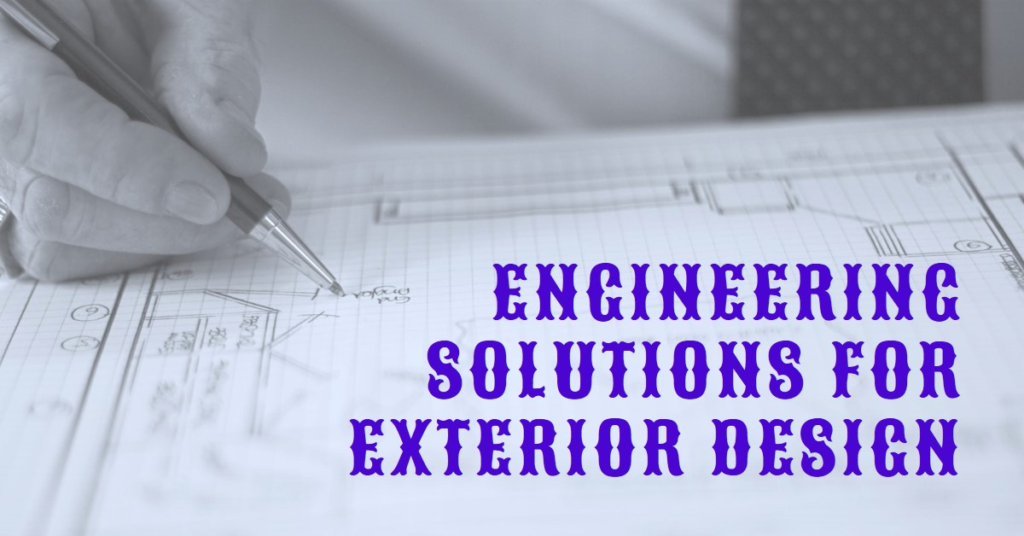
Table of Contents
- Introduction:
- Harmonizing Aesthetics and Functionality:
- Adapting to Climate and Environmental Conditions:
- Ensuring Structural Integrity and Safety:
- Embracing Sustainable Design Practices:
- Leveraging Advanced Technologies:
- Navigating Regulatory and Zoning Requirements:
- Addressing Acoustical Challenges:
- Integrating Smart Technologies:
- Achieving Aesthetic Flexibility:
- Conclusion: The Future of Exterior Design Engineering
Introduction:
Exterior design plays a crucial role in defining the aesthetic appeal and functional efficiency of buildings. However, designers often encounter numerous challenges that require innovative engineering solutions. This blog explores how professionals overcome these hurdles to create resilient and visually stunning exteriors.
Harmonizing Aesthetics and Functionality:
One of the primary challenges in exterior design is balancing aesthetic appeal with functional requirements. Architects and engineers must work together to ensure that the building’s exterior is not only beautiful but also practical and durable. This requires a deep understanding of materials, environmental factors, and user needs.
Engineers use advanced materials and construction techniques to create facades that are both attractive and resilient. For instance, using composite materials that mimic natural stone can provide the desired visual effect while offering superior durability and lower maintenance costs. Additionally, integrating features like self-cleaning glass or photovoltaic panels can enhance both the building’s performance and its aesthetic appeal.
Adapting to Climate and Environmental Conditions:
Another significant challenge in exterior design is adapting to various climate and environmental conditions. Buildings must withstand extreme weather, fluctuating temperatures, and environmental pollutants. Engineers address these issues by selecting appropriate materials and incorporating climate-responsive design elements.
For example, in regions with high humidity, materials resistant to mold and corrosion are essential. In areas prone to extreme temperatures, incorporating thermal insulation and reflective coatings can help maintain interior comfort while reducing energy consumption. Additionally, green roofs and walls can mitigate urban heat islands, improve air quality, and enhance the building’s thermal performance.
Ensuring Structural Integrity and Safety:
Ensuring the structural integrity and safety of exterior designs is paramount. Engineers must consider the forces of wind, seismic activity, and other environmental stresses that can affect a building’s stability. Advanced modeling software and simulation tools are instrumental in predicting and mitigating potential structural issues.
By conducting thorough site analyses and using state-of-the-art technologies, engineers can design exteriors that withstand natural forces. Reinforced concrete, steel framing, and tensioned membrane structures are some of the solutions that provide the necessary strength and flexibility to endure these challenges. Additionally, implementing stringent building codes and standards ensures that safety is not compromised.
Embracing Sustainable Design Practices:
Sustainability is a key consideration in modern exterior design. Engineers and designers are increasingly focused on creating buildings that minimize environmental impact and promote energy efficiency. This involves the use of sustainable materials, renewable energy sources, and innovative design strategies.
Incorporating features such as solar panels, rainwater harvesting systems, and green insulation materials can significantly reduce a building’s carbon footprint. Moreover, designing buildings to maximize natural light and ventilation reduces the need for artificial lighting and air conditioning, further enhancing sustainability. These practices not only benefit the environment but also result in long-term cost savings for building owners.
Leveraging Advanced Technologies:
The advent of advanced technologies has revolutionized exterior design. Tools such as Building Information Modeling (BIM), 3D printing, and virtual reality (VR) allow engineers and architects to visualize, test, and refine their designs with unprecedented precision.:
BIM enables the creation of detailed digital models that incorporate all aspects of a building’s exterior. This facilitates collaboration among stakeholders and ensures that potential issues are identified and resolved early in the design process. Similarly, 3D printing allows for the creation of complex façade elements that were previously difficult or impossible to produce. VR technology offers immersive experiences that help clients and designers visualize the final outcome and make informed decisions.
Navigating Regulatory and Zoning Requirements:
Regulatory and zoning requirements can pose significant challenges in exterior design. Engineers must navigate a complex web of local, state, and federal regulations that govern aspects such as building height, setbacks, and façade materials. Compliance with these regulations is essential to avoid costly delays and ensure the project’s success.
Engineers and architects must stay informed about current regulations and work closely with regulatory bodies to ensure compliance. This often involves preparing detailed documentation, attending public hearings, and making necessary design adjustments. By proactively addressing regulatory requirements, design teams can avoid potential pitfalls and ensure a smooth project approval process.


Addressing Acoustical Challenges:
Acoustical performance is an often-overlooked aspect of exterior design, yet it is crucial for occupant comfort. Buildings located in noisy environments, such as urban centers or near highways, require effective soundproofing solutions to minimize noise pollution.
Engineers employ various strategies to enhance acoustical performance. This includes using sound-absorbing materials, designing buffer zones, and incorporating sound barriers into the exterior façade. Double-glazed windows and acoustic panels can also significantly reduce noise infiltration, creating a more serene indoor environment. By addressing acoustical challenges, designers can enhance the overall livability of a building.
Integrating Smart Technologies:
The integration of smart technologies into exterior design is rapidly becoming a standard practice. Smart façades, lighting systems, and climate control technologies enhance both the functionality and energy efficiency of buildings.
Smart façades can adjust to changing environmental conditions by altering their opacity or thermal properties, optimizing energy use and improving occupant comfort. Intelligent lighting systems can adapt to natural light levels, reducing energy consumption and enhancing visual appeal. Moreover, incorporating IoT (Internet of Things) devices allows for real-time monitoring and control of various building systems, leading to improved performance and maintenance.
Achieving Aesthetic Flexibility:
Achieving aesthetic flexibility while maintaining structural integrity and functionality is a significant challenge in exterior design. Buildings must cater to diverse tastes and evolving architectural trends, often requiring adaptable and versatile design solutions.
Engineers and architects are now using modular design approaches and customizable façade systems to achieve this flexibility. Modular components can be easily replaced or upgraded, allowing buildings to adapt to changing needs and preferences. Additionally, the use of dynamic materials, such as electrochromic glass, enables façades to change appearance based on external conditions or user inputs, providing a modern and versatile aesthetic.
Conclusion: The Future of Exterior Design Engineering
In conclusion, engineering solutions are essential in overcoming the myriad challenges associated with exterior design. By harmonizing aesthetics and functionality, adapting to environmental conditions, ensuring structural integrity, embracing sustainability, leveraging advanced technologies, navigating regulatory requirements, addressing acoustical challenges, integrating smart technologies, and achieving aesthetic flexibility, engineers and architects can create buildings that are not only visually stunning but also resilient and efficient.
As technology continues to advance, the possibilities for innovative exterior design solutions will expand, paving the way for a new era of architectural excellence. By staying at the forefront of these developments, professionals in the field can continue to push the boundaries of what is possible, creating built environments that are both beautiful and sustainable for future generations.



